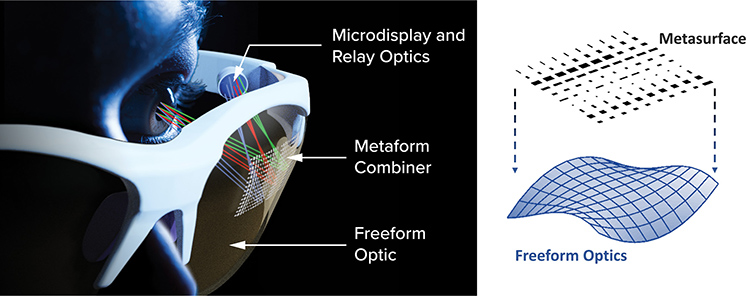 Left: An example of a metaform combiner application in an augmented-reality display. Right: An illustration of the metaform concept, showing a metasurface conformed to a freeform substrate.
Left: An example of a metaform combiner application in an augmented-reality display. Right: An illustration of the metaform concept, showing a metasurface conformed to a freeform substrate.
The technological demands of modern consumer devices such as displays for augmented and virtual reality (AR/VR) and mobile cameras exceed what is possible with conventional optics. The challenging requirements for device compactness, image quality and weight necessitate the discovery and implementation of new optical components and architectures. Two optical technologies of particular interest in the last decade are freeform optics and metasurfaces.1,2 In work published this year, we developed design-to-fabrication processes that combine these technologies to build a new optical component—a metaform.
Freeform optical surfaces are surfaces with no axis of rotational invariance (within or beyond the optical part).3 Freeform optics is a cornerstone of the recent revolution in optical design.1 Developments in nodal aberration theory have also led to a new design framework for freeform optics.4 This methodology, combined with advances in fabrication and testing, has made freeform optics a viable technology for the miniaturization of optical devices.3
While freeform optics control light based on the intrinsic curved shape of the freeform surface, metasurfaces achieve light control via light interaction with subwavelength structures decorating a planar surface. To date, various optical components such as lenses, polarizers, and diffraction gratings have been implemented using flat metasurfaces.2
Recently, we realized a new optical component we call a metaform.5 A metaform consists of a metasurface conformed to a curved freeform substrate. We built on the previously developed freeform design framework to leverage the imaging advantages of both freeform optics and metasurfaces. We also developed an enhanced electron beam lithography process (typically only used on flat substrates) to make metaform fabrication possible.
To demonstrate the application of metaform optics, we chose an application scenario inspired by the needs of AR displays. A common challenge with free-space-combiner-based AR displays is an undesirable form factor where the combiner mirror is tilted towards the user’s face—resulting in a “bug-eye” appearance. Using a metaform mirror as the combiner resolves this problem by leveraging the metasurface to tilt the image without tilting the metaform itself. Furthermore, the imaging function of the metaform can be distributed between the freeform substrate and the metasurface based on the developed aberration theory and design framework. The resulting device is a miniature imager with a desirable form factor that can fit within typical sunglasses.
We believe that the design-to-fabrication processes we developed make metaform optics a viable technology for more compact AR/VR eyewear, as well as for applications ranging from LED lighting to medical and military optical devices.
Researchers
Daniel K. Nikolov, Aaron Bauer, A. Nick Vamivakas and Jannick P. Rolland, University of Rochester, Rochester, NY, USA
References
1. K.P. Thompson and J.P. Rolland. Opt. Photon. News 23(6) 30 (2012).
2. P. Genevet et al. Optica 4, 139 (2017).
3. J.P. Rolland et al. Optica 8, 161 (2021).
4. A. Bauer et al. Nat. Commun. 9, 1 (2018).
5. D.K. Nikolov et al. Sci. Adv.7, eabe5112 (2021).
